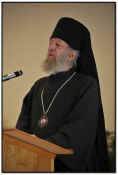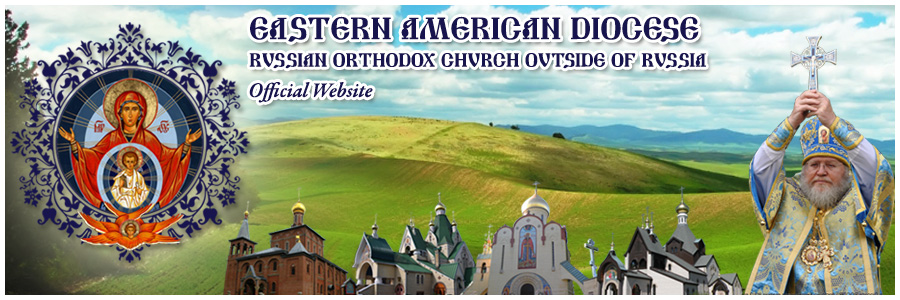March
16, 2009
Bishop Jerome's lecture at the Diocesan General Meeting
From
the Editors: On Monday, March 16, at the Diocesan Meeting, His Grace,
Bishop Jerome of Manhattan, shared some his memories of the
ever-memorable Archbishop Nikon, who is buried in the Church of the
Protection of the Mother of God, the lower church of St. Vladimir
Memorial Church in Jackson, NJ. Below we publish segments of his remarks.
 When,
in the spring of 1971, I was nearing graduation from Holy Trinity
Seminary in Jordanville, I was advised that Archbishop Nikon was in need
of a kelleinik, or helper.
Hearing of this, Fr. Gury said the following of Vladyka, “There is the
holiest of services.”
When,
in the spring of 1971, I was nearing graduation from Holy Trinity
Seminary in Jordanville, I was advised that Archbishop Nikon was in need
of a kelleinik, or helper.
Hearing of this, Fr. Gury said the following of Vladyka, “There is the
holiest of services.”
Currently,
schismatics, fanatics, and enemies of our Church like to distort the
memory of our previous hierarchs. They depict them as having been
fanatics and neo-Pharisees, like unto themselves: filled with nothing
but bitterness and hatred. Since new generations are growing up that
never knew the church life of the recent past, nor the practices, nor
yet the “old school clergy,” they may believe such disinformation
and be led into error.
Vladyka
Nikon went to the Lord in 1976. That means no one under the age of 33
saw him at all, and no one younger than 50 today was old enough then to
know or recall Vladyka’s views. Therefore it is worth telling
something about him.
Archbishop
Nikon, in the world Nikolai Pavlovich Rklitsky (the surname is derived
from a river in central Europe called the “Rklik”), was born in 1892
in the town of Borki near Chernigov, where his father, Fr. Pavel
Rklitsky, was the pastor and dean of the district. Nikolai, who was
still a boy when Fr. Pavel passed away, studied at a theological
seminary across the road from the noted Eletsky monastery. Later, he
served in the Russian army, and during World War I, when Nikolai was
already 25, the Russian Revolution occurred. Evacuated with the remnants
of the White Army in 1920, he lived in Serbia between the wars, and was
a disciple and close associate of Metropolitan Anthony Khrapovitsky,
whose biographer he later became. During World War II he took monastic
vows and was ordained to the priesthood, and in 1948 was consecrated
bishop. He served as hierarch for 28 years, first as vicar-bishop, and
later as Ruling Bishop of the Eastern American and New York Diocese till
his repose in 1976.
And
so, his personal experience as the son of a parish
priest-and-administrator, and as student of theology in Russia before
the Revolution, along with the advice and spiritual direction of
Metropolitan Anthony Khrapovitsky in Serbia, and finally his experience
as a pastor and then archpastor in the lands of the Diaspora, were
sources of Vladyka’s views on how to rule the Church.
For
Vladyka Nikon, as for Metropolitan Anthony, “outside the Orthodox
Church there is only darkness.” Consequently, within
the Church a good deal of variety can be permitted, so long as the unity
of the Church of Christ, in Grace and dogma, is kept.
In
other words, we must do everything to keep the flock within the fold of
the Orthodox faith among those outside the Church.
Vladyka
Nikon believed absolutely in the future resurrection of Russia and of
the Russian monarchy, and that one day, the reborn Russia would assume a
dominant role in the world. He was also convinced that the division in
the Russian Church (that is, between the Church Abroad and the Church in
Russia) would come to an end, and that the center of our Church would
again be in Russia. But, at the same time, Vladyka was also a supporter
of missionary work among non-Russians. He was both a Russian
monarchist-patriot, and a missionary to other peoples.
Those
were often difficult times. In 1965, a Greek-American monastery in
Brookline, MA was received into the Church Abroad, with its founder, the
priestmonk Panteleimon (Metropoulos, not
to be confused with Archimandrite Panteleimon (Nizhnik), who founded the
Jordanville monastery in 1930). That priestmonk, through followers whom
he had led into his “stricter” teachings, began to undermine both
the traditional practices of the Russian Church, and then the hierarchy
itself. But it was a curious “strictness” that Fr. Panteleimon (Metropoulos)
and his coterie applied only to others, not to themselves.
Here
is an example of false “strictness:” “spiritual teachers” who
claim that the Russian Church has been wrong in approving mixed
marriages, and that it is better for spouses to live in sin, if one of
them is not Orthodox, in or outside a secular marriage, than to enter
into a “mixed marriage” as permitted by the Russian Church: since in
their view a mixed marriage would be unacceptable. Thus there was a
discrepancy between what the Church actually
teaches or allows, and what the Church “should teach,” or “should
not permit.”
At
the same time, there arose conflicts between the Russian and non-Russian
members and the communities of the Church Abroad. Masterfully playing
his role, the Boston charlatan either made the non-Russians into his
followers, or drove their communities out of ROCOR. Thanks to the direct
or indirect influence of the “Boston Elder,” the Church Abroad lost
four non-Russian dioceses between 1967 and 1976.
I
well remember how, in the early 1970s, one zealot at the St. Vladimir
Memorial Church began putting a would-be convert out of the church at
the dismissal of the catechumens. On hearing this, Vladyka Nikon ordered
it to be stopped, since there had never been such a practice in the
Russian Church, and it served only to offend.
Vladyka
Nikon gave his moral support to “missionary services” in other
languages, as well as to the idea of restoring Western Orthodoxy. He saw
no harm in allowing the use of the new calendar (but only if needed in
missionary parishes, “it would be very foolish for us
to go over to it!” he once said to me). He gave his blessing for the
reception of converts, even after the 1971 Montreal Sobor, as
previously, without rebaptism. Not infrequently, there were requests for
permission to hold weddings on Saturdays or in fasting periods, and
Vladyka cooperated with pastoral love. Everything was done with the
purpose of spreading the Orthodox faith, and encouraging the children of
the Russian Diaspora to remain Orthodox.
Vladyka
showed a fatherly love to everyone. He was always accessible, he always
answered personal letters himself (unless translation was needed), and
it was not unusual for him to write 12 or 15 relatively short replies a
day. He was mild and kind to the clergy, in some cases even if they were
from another jurisdiction. For example, when Fr. Peter Popov’s
matushka reposed (he was the priest at the OCA parish in Jackson, NJ),
Vladyka phoned him to express condolences. After that, Fr. Peter began
sometimes to be seen at our ROCOR services at St. Vladimir Memorial
Church.
But
when it was necessary, Vladyka could also be quite firm, and impose
discipline where it was called for.
In
short, for Vladyka Nikon, the grace filled content of Church life was
more important than the external forms. He was no “liberal,” but
always tried to keep the faithful within the Orthodox Church, lest they
fall away. For the non-Orthodox, he wished them to find the path of
truth, leading the true believers to the Kingdom of God.
And
may the merciful and almighty Lord grant us the same!
Amen.
Media
Office of the Eastern American Diocese


